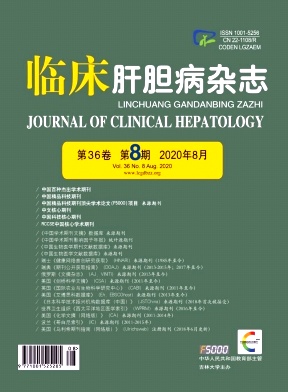|
[1] Pancreas Study Group,Chinese Society of Gastroenterology,Chinese Medical Association; Editorial Board of Chinese Journal of Pancreatology; Editorial Board of Chinese Journal of Digestion. Chinese guidelines for the management of acute pancreatitis(Shenyang,2019)[J]. J Clin Hepatol,2019,35(12):2706-2711.(in Chinese)中华医学会消化病学分会胰腺疾病学组,《中华胰腺病杂志》编委会,《中华消化杂志》编委会.中国急性胰腺炎诊治指南(2019年,沈阳)[J].临床肝胆病杂志,2019,35(12):2706-2711.
|
|
[2] BANKS PA,BOLLEN TL,DERVENIS C,et al. Classification of acute pancreatitis—2012:Revision of the Atlanta classification and definitions by international consensus[J]. Gut,2013,62(1):102-111.
|
|
[3] Metabolic Syndrome Research Collaboration Group from Chinese Diabetes Society. Suggestions on metabolic syndrome from Chinese Diabetes Society[J]. Chin J Diabetes,2004,12(3):156-161.(in Chinese)中华医学会糖尿病学分会代谢综合征研究协作组.中华医学会糖尿病学分会关于代谢综合征的建议[J].中华糖尿病杂志,2004,12(3):156-161.
|
|
[4] PREZ-MARTNEZ P,MIKHAILIDIS DP,ATHYROS VG,et al. Lifestyle recommendations for the prevention and management of metabolic syndrome:An international panel recommendation[J]. Nutr Rev,2017,75(5):307-326.
|
|
[5] CORNIER MA,DABELEA D,HERNANDEZ TL,et al. The metabolic syndrome[J]. Endocr Rev,2008,29(7):777-822.
|
|
[6] SHEN XB,YIN Y. The relationship between metabolic syndrome and prognosis of patients with acute cerebral infarction[J]. Traum Crit Med,2019,7(3):184-186.(in Chinese)沈小波,殷艳.代谢综合征与急性脑梗死患者预后关系研究[J].创伤与急危重病医学,2019,7(3):184-186.
|
|
[7] DOBSZAI D,MTRAI P,GYNGYI Z,et al. Body-mass index correlates with severity and mortality in acute pancreatitis:A meta-analysis[J]. World J Gastroenterol,2019,25(6):729-743.
|
|
[8] SAWALHI S,AL-MARAMHY H,ABDELRAHMAN AI,et al.Does the presence of obesity and/or metabolic syndrome affect the course of acute pancreatitis? A prospective study[J].Pancreas,2014,43(4):565-570.
|
|
[9] KRISHNA SG,HINTON A,OZA V,et al. Morbid obesity is associated with adverse clinical outcomes in acute pancreatitis:A propensity-matched study[J]. Am J Gastroenterol,2015,110(11):1608-1619.
|
|
[10] GREGOR MF,HOTAMISLIGIL GS. Inflammatory mechanisms in obesity[J]. Annu Rev Immunol,2011,29(1):415-445.
|
|
[11] HENAO-MEJIA J,ELINAV E,JIN C,et al. Inflammasomemediated dysbiosis regulates progression of NAFLD and obesity[J]. Nature,2012,482(7384):179-185.
|
|
[12] KHATUA B,EL-KURDI B,SINGH VP. Obesity and pancreatitis[J]. Curr Opin Gastroenterol,2017,33(5):374-382.
|
|
[13] VARELA JE,HINOJOSA M,NGUYEN N. Correlations between intra-abdominal pressure and obesity-related co-morbidities[J]. Surg Obes Relat Dis,2009,5(5):524-528.
|
|
[14] SADR-AZODI O,ORSINI N,ANDRN-SANDBERG A,et al. Abdominal and total adiposity and the risk of acute pancreatitis:A population-based prospective cohort study[J].Am J Gastroenterol,2013,108(1):133-139.
|
|
[15] DING Y,ZHANG M,WANG L,et al. Association of the hypertriglyceridemic waist phenotype and severity of acute pancreatitis[J]. Lipids Health Dis,2019,18(1):93.
|
|
[16] FREITAS RS,FONSECA MJMD,SCHMIDT MI,et al. Hypertriglyceridemic waist phenotype:Associated factors and comparison with other cardiovascular and metabolic risk indicators in the ELSA-Brasil study[J]. Cad Saude Publica,2018,34(4):e00067617.
|
|
[17] ZHANG Y,GUO F,LI S,et al. Decreased high density lipoprotein cholesterol is an independent predictor for persistent organ failure,pancreatic necrosis and mortality in acute pancreatitis[J]. Sci Rep,2017,7(1):8064.
|
|
[18] ZHOU CL,ZHANG CH,ZHAO XY,et al. Early prediction of persistent organ failure by serum apolipoprotein A-I and high-density lipoprotein cholesterol in patients with acute pancreatitis[J]. Clin Chim Acta,2018,476:139-145.
|
|
[19] SILVA-VAZ P,ABRANTES AM,CASTELO-BRANCO M,et al. Multifactorial scores and biomarkers of prognosis of acute pancreatitis:Applications to research and practice[J].Int J Mol Sci,2020,21(1):e338.
|









 本站查看
本站查看




 DownLoad:
DownLoad: